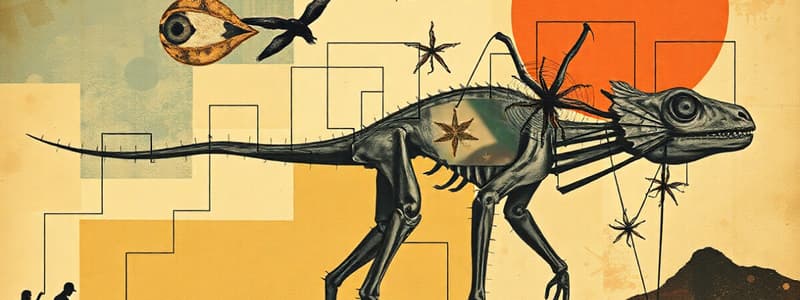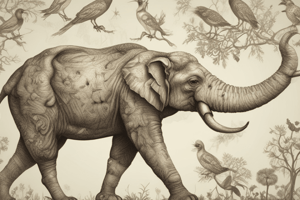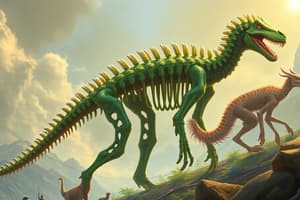Podcast
Questions and Answers
Which discipline is primarily concerned with the classification and naming of organisms?
Which discipline is primarily concerned with the classification and naming of organisms?
- Physiology
- Genetics
- Ecology
- Taxonomy (correct)
Which of the following taxonomic categories contains the fewest number of species?
Which of the following taxonomic categories contains the fewest number of species?
- Family
- Order
- Genus (correct)
- Class
In a phylogenetic tree, what does a branch point represent?
In a phylogenetic tree, what does a branch point represent?
- Extinction of a species
- Origin of a new species
- Common ancestor (correct)
- Geographic isolation
What is a polytomy in a phylogenetic tree?
What is a polytomy in a phylogenetic tree?
Similarities in the bone structure of a bat's wing and a human's arm are an example of:
Similarities in the bone structure of a bat's wing and a human's arm are an example of:
The wings of a bird and the wings of an insect are examples of:
The wings of a bird and the wings of an insect are examples of:
What is the key principle behind the concept of parsimony in phylogenetic analysis?
What is the key principle behind the concept of parsimony in phylogenetic analysis?
What is a clade?
What is a clade?
A valid clade is ________, meaning that it consists of an ancestral species and all its descendants.
A valid clade is ________, meaning that it consists of an ancestral species and all its descendants.
Which of the following describes a paraphyletic group?
Which of the following describes a paraphyletic group?
What defines a polyphyletic group?
What defines a polyphyletic group?
Hair in mammals is an example of a:
Hair in mammals is an example of a:
What is an outgroup used for when constructing a cladogram?
What is an outgroup used for when constructing a cladogram?
What is the purpose of a transitional fossil in understanding phylogeny?
What is the purpose of a transitional fossil in understanding phylogeny?
What is the goal of applying the principle of maximum likelihood in constructing phylogenetic trees?
What is the goal of applying the principle of maximum likelihood in constructing phylogenetic trees?
Given a DNA sequence alignment, which phylogenetic tree is considered the most parsimonious?
Given a DNA sequence alignment, which phylogenetic tree is considered the most parsimonious?
In the context of molecular phylogenies, what is the significance of using DNA that codes for rRNA?
In the context of molecular phylogenies, what is the significance of using DNA that codes for rRNA?
Which type of genes can arise from gene duplication within a species?
Which type of genes can arise from gene duplication within a species?
What is the key characteristic of orthologous genes?
What is the key characteristic of orthologous genes?
What is the concept of the molecular clock used for?
What is the concept of the molecular clock used for?
Why are phylogenetic hypotheses constantly revised?
Why are phylogenetic hypotheses constantly revised?
Which of the following is NOT one of the three domains of life?
Which of the following is NOT one of the three domains of life?
How does horizontal gene transfer complicate the construction of phylogenetic trees?
How does horizontal gene transfer complicate the construction of phylogenetic trees?
Which of the following is a key assumption of molecular clocks?
Which of the following is a key assumption of molecular clocks?
Which process is most likely to lead to analogous structures?
Which process is most likely to lead to analogous structures?
A systematist is studying the evolutionary history of a group of plants. They identify a particular morphological trait that is shared by all members of the group, but also found in distantly related groups. Which term best describes this trait?
A systematist is studying the evolutionary history of a group of plants. They identify a particular morphological trait that is shared by all members of the group, but also found in distantly related groups. Which term best describes this trait?
In comparing different possible phylogenetic trees, a researcher calculates the number of evolutionary changes required for each. They choose the tree that requires the fewest changes. Which principle is the researcher applying?
In comparing different possible phylogenetic trees, a researcher calculates the number of evolutionary changes required for each. They choose the tree that requires the fewest changes. Which principle is the researcher applying?
A gene is duplicated in a species. Over time, the two copies diverge, with one copy taking on a completely new function that benefits the organism. What is this process called?
A gene is duplicated in a species. Over time, the two copies diverge, with one copy taking on a completely new function that benefits the organism. What is this process called?
Which of the following would be the LEAST useful when constructing a phylogeny of a group of closely related animal species?
Which of the following would be the LEAST useful when constructing a phylogeny of a group of closely related animal species?
Which is something that molecular clocks are often calibrated against?
Which is something that molecular clocks are often calibrated against?
Which of the following is an example of horizontal gene transfer?
Which of the following is an example of horizontal gene transfer?
A researcher discovers a new organism. Initial analysis shows it has a cell wall made of psuedopeptidoglycan, and lives in extreme environments. In which domain of life would this organism likely be classified?
A researcher discovers a new organism. Initial analysis shows it has a cell wall made of psuedopeptidoglycan, and lives in extreme environments. In which domain of life would this organism likely be classified?
What is the relationship between systematics and taxonomy?
What is the relationship between systematics and taxonomy?
A group consisting of an ancestor, but all of the ancestor's descendants are not included, is referred to as:
A group consisting of an ancestor, but all of the ancestor's descendants are not included, is referred to as:
Which of the following best describes the usefulness of mtDNA in phylogenetics?
Which of the following best describes the usefulness of mtDNA in phylogenetics?
Which of the following characterisics is LEAST helpful for developing a phylogenetic tree?
Which of the following characterisics is LEAST helpful for developing a phylogenetic tree?
Why is it vital to distinguish homology from analogy when inferring phylogeny?
Why is it vital to distinguish homology from analogy when inferring phylogeny?
In cladistics, what is the term for a shared derived character?
In cladistics, what is the term for a shared derived character?
What is the relationship between shared ancestral characters and shared derived characters?
What is the relationship between shared ancestral characters and shared derived characters?
Which statement explains why systematists utilize both morphological and molecular data to infer phylogenies?
Which statement explains why systematists utilize both morphological and molecular data to infer phylogenies?
How does the concept of shared ancestry relate to the determination of homologies?
How does the concept of shared ancestry relate to the determination of homologies?
What is the significance of the arrangement of clades within larger clades?
What is the significance of the arrangement of clades within larger clades?
How does the classification of organisms into groups relate to their evolutionary history?
How does the classification of organisms into groups relate to their evolutionary history?
Why is it important for a clade to be monophyletic in cladistics?
Why is it important for a clade to be monophyletic in cladistics?
What challenge does horizontal gene transfer pose to phylogenetic analysis, and how can it affect our understanding of evolutionary relationships?
What challenge does horizontal gene transfer pose to phylogenetic analysis, and how can it affect our understanding of evolutionary relationships?
When constructing phylogenetic trees, why is it useful to use genes that code for rRNA?
When constructing phylogenetic trees, why is it useful to use genes that code for rRNA?
Why are phylogenetic hypotheses viewed as works in progress that are subject to change?
Why are phylogenetic hypotheses viewed as works in progress that are subject to change?
What distinguishes orthologous genes from paralogous genes in molecular evolution?
What distinguishes orthologous genes from paralogous genes in molecular evolution?
How does the concept of parsimony guide the construction of phylogenetic trees?
How does the concept of parsimony guide the construction of phylogenetic trees?
An evolutionary biologist is using a molecular clock to determine when a group of related organisms diverged. To do this, what must they do?
An evolutionary biologist is using a molecular clock to determine when a group of related organisms diverged. To do this, what must they do?
How can transitional fossils help in understanding broad patterns of evolution?
How can transitional fossils help in understanding broad patterns of evolution?
Why is it important to differentiate between orthologous and paralogous genes when using molecular data to reconstruct phylogenetic relationships?
Why is it important to differentiate between orthologous and paralogous genes when using molecular data to reconstruct phylogenetic relationships?
What key assumption is crucial for the effective use of molecular clocks in tracing evolutionary time?
What key assumption is crucial for the effective use of molecular clocks in tracing evolutionary time?
Why does the study of molecular phylogenies often focus on genes that are universally distributed across many distantly related groups?
Why does the study of molecular phylogenies often focus on genes that are universally distributed across many distantly related groups?
How does cladistics approach the classification of organisms?
How does cladistics approach the classification of organisms?
Which statement applies when a group of animals has an ancestral species paired with some, but not all, of its descendants?
Which statement applies when a group of animals has an ancestral species paired with some, but not all, of its descendants?
How do you determine the most parsimonious tree possible, based on DNA sequence data?
How do you determine the most parsimonious tree possible, based on DNA sequence data?
Hair on mammals, when compared to other vertebrates, is an example of a:
Hair on mammals, when compared to other vertebrates, is an example of a:
For constructing cladograms, it is important to find suitable outgroup species. Which species should you incorporate as an outgroup?
For constructing cladograms, it is important to find suitable outgroup species. Which species should you incorporate as an outgroup?
Flashcards
Taxonomy
Taxonomy
The scientific discipline concerned with classifying and naming organisms.
Phylogeny
Phylogeny
The evolutionary history of a species or group of species.
Systematics
Systematics
A discipline focused on classifying organisms and determining their evolutionary relationships.
Taxonomic hierarchy
Taxonomic hierarchy
Signup and view all the flashcards
Binomial nomenclature
Binomial nomenclature
Signup and view all the flashcards
Phylogenetic tree
Phylogenetic tree
Signup and view all the flashcards
Branch point
Branch point
Signup and view all the flashcards
Sister taxa
Sister taxa
Signup and view all the flashcards
Basal taxon
Basal taxon
Signup and view all the flashcards
Polytomy
Polytomy
Signup and view all the flashcards
Homologies
Homologies
Signup and view all the flashcards
Convergent evolution
Convergent evolution
Signup and view all the flashcards
Analogous structures
Analogous structures
Signup and view all the flashcards
Maximum parsimony
Maximum parsimony
Signup and view all the flashcards
Maximum likelihood
Maximum likelihood
Signup and view all the flashcards
Clade
Clade
Signup and view all the flashcards
Monophyletic
Monophyletic
Signup and view all the flashcards
Paraphyletic group
Paraphyletic group
Signup and view all the flashcards
Polyphyletic group
Polyphyletic group
Signup and view all the flashcards
Shared derived character
Shared derived character
Signup and view all the flashcards
Shared ancestral character
Shared ancestral character
Signup and view all the flashcards
Outgroup
Outgroup
Signup and view all the flashcards
Phylogenetic trees
Phylogenetic trees
Signup and view all the flashcards
rRNA genes
rRNA genes
Signup and view all the flashcards
mtDNA
mtDNA
Signup and view all the flashcards
Orthologous genes
Orthologous genes
Signup and view all the flashcards
Paralogous genes
Paralogous genes
Signup and view all the flashcards
Molecular clock
Molecular clock
Signup and view all the flashcards
Horizontal gene transfer
Horizontal gene transfer
Signup and view all the flashcards
Eukarya
Eukarya
Signup and view all the flashcards
Bacteria and Archaea
Bacteria and Archaea
Signup and view all the flashcards
Study Notes
- Phylogeny covers the study of evolutionary relationships and the tree of life
Taxonomy
- Taxonomy is synonymous with systematics
- It is the scientific discipline of classifying and naming organisms
Taxonomic Categories
- Species: Panthera pardus (leopard)
- Genus: Panthera (panther, cheetah)
- Family: Felidae (lion, house cat)
- Order: Carnivor(e) (dogs, seals, bears)
- Class: Mammalia (human, mice, moose)
- Phylum: Chordata (snakes, birds, fish)
- Kingdom: Animalia (jellyfish, slugs)
- Domain: Eukarya (tree, mushroom)
- Domain: Bacteria and Archea
Phylogenies
- Show evolutionary relationships
- Inferred from morphological and molecular data
- Systematists gather data about morphology, genes, and biochemistry of living organisms to infer phylogenies
Homologies
- Phenotypic and genetic similarities from shared ancestry
Homologous structures
- Animals that have them probably evolved from the same ancestor
Parsimony
- Phylogenies seek the fewest number of character changes
- They use shared characters to construct phylogenetic trees
- Once homologous characters are identified, they can infer a phylogeny
Cladistics
- Groups organisms by common descent.
- A clade is a group of species that includes an ancestral species and all its descendants
- Clades can be nested in larger clades, but not all groupings of organisms qualify as clades
- Valid clade is monophyletic, signifying that it consists of the ancestor species and all its descendants
Phylogenetic groupings
- Monophyletic group (clade): Includes a common ancestor and all of its descendants
- Paraphyletic group: Includes a common ancestor, but not all of its descendants
- Polyphyletic group: Includes members of multiple groups, excluding the common ancestor
Types of characters
- Shared ancestral character: Originated in an ancestor of the taxon
- Shared derived character: Evolutionary novelty unique to a particular clade
Organism evolutionary history
- Documented in its genome
- A valuable approach for tracing a lineage is to compare nucleic acids or other molecules to infer relatedness
- DNA that codes for rRNA changes gradually, so it is useful for investigating branching points hundreds of millions of years ago
- mtDNA evolves rapidly, thus, useful to explore recent evolutionary events
Genome evolution
- Orthologous genes are widespread and extend across many widely varied species
- Humans and mice diverged about 65 million years ago, and 99% of genes are orthologous
Molecular clocks
- Help track evolutionary time
- To extend phylogenies beyond the fossil record assume rate of molecular change over time
Horizontal gene transfer
- Contributes to disparities between gene trees
- It plays a key role in the evolution of both prokaryotes and eukaryotes
Studying That Suits You
Use AI to generate personalized quizzes and flashcards to suit your learning preferences.




